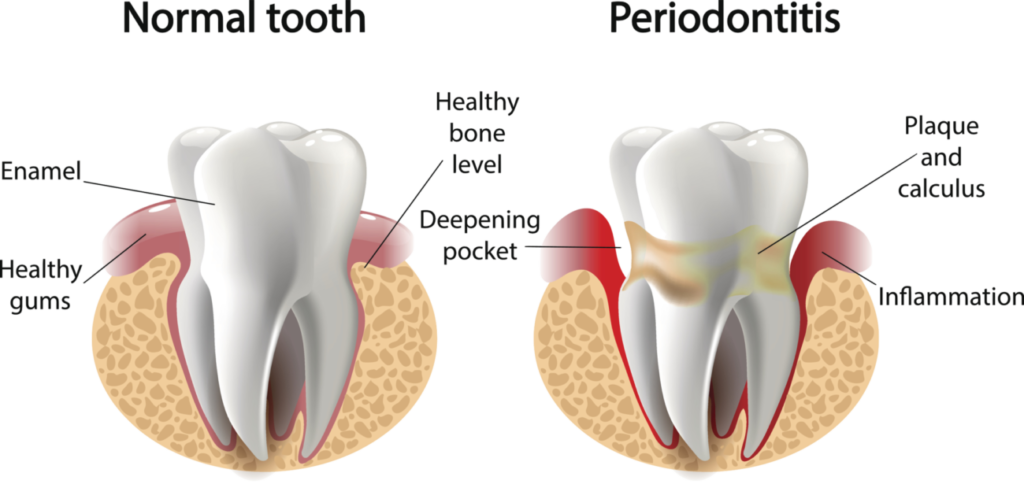Most individuals will be affected by gum disease (periodontal disease) at some point in their lives – even those who take excellent care of their teeth and gums. Periodontal disease can develop when plaque builds up along the teeth and the gumline, causing deep pockets to form between the teeth and gum tissue, ultimately allowing harmful bacteria to multiply. When left untreated, this can lead to a progressively worse infection that can produce severe oral and possibly even general health conditions later on. Our cosmetic dentist, Jimmy Wu, DDS, offers a range of advanced treatment options – including laser dentistry – to address this very common concern.
- Periodontal Disease Causes
- Periodontal Disease Symptoms
- Gum Disease Stages
- Gum Disease Treatment Candidates
- Gum Disease Treatments
- Laser Gum Disease vs. Traditional Gum Disease Treatment
- Gum Disease Treatment Side Effects
- Gum Disease Treatment Aftercare
- Gum Disease Health Risks
- Gum Disease Prevention
- Gum Disease Treatment Cost
What Are Common Causes of Periodontal Disease?
Periodontal (gum) disease is typically caused by an invasion of bacteria in soft oral tissues. The bacteria builds to a point that it develops into plaque, and then hardens into tartar (or calculus). Daily brushing and flossing routines can help eliminate plaque, but once it hardens into tartar, this becomes more challenging, and a professional dental cleaning is necessary to remove it.
Some of the reasons why gum disease can develop include:
- Inadequate at-home dental hygiene routines
- Infrequent trips to the dentist for professional dental care
- Bruxism (teeth clenching and grinding)
- The use of tobacco products
- Certain illnesses or medical conditions
- Nutritional deficiencies
- Hormonal changes
If a buildup of bacteria and tartar continues without treatment, gum disease will likely continue to get worse, ultimately resulting in symptoms that endanger the health of both the gums and the teeth, as well as increased risks to one’s general health.
What Are the Symptoms of Periodontal Disease?
Some of the potential symptoms of gum disease include:
- Sensitivity, redness, swelling, and/or inflammation among the gums
- Gums that bleed easily
- Receding gums
- Enlarged, deep pockets between the gums and teeth
- Teeth that feel loose
- A change in the bite
- A discharge of pus between the teeth or along the gumline
- Tooth loss
- Chronic halitosis (bad breath)
- A chronic bad-taste sensation
- A change in the fit of dentures
Are There Different Stages of Gum Disease?
Gum disease is a staged condition depending upon its severity when diagnosed. The different stages of gum disease are:
Gingivitis
Gingivitis is the earliest stage of periodontal disease. When at-home oral hygiene routines fail to remove plaque, gingivitis can set in as the bacteria begins irritating the gum tissue. Bleeding gums while brushing and flossing is not uncommon during this stage. With that in mind, gingivitis can often be reversed since the problem typically has not yet affected connective tissue and bone that keep the teeth in place. Gingivitis may not present any symptoms at all, even though it has already developed. This makes it very important to attend all of the recommended dental appointments each year for thorough evaluation and routine dental cleanings.
Periodontitis
This is the stage where gum disease starts getting even more serious. Periodontitis occurs when bone and connective tissues are not only affected by the bacteria, but are also irreversibly damaged. Pockets may begin to develop below the gumline at this stage of gum disease, and plaque and food can settle within these pockets. With improvements in at-home oral hygiene regimens, in addition to professional periodontal care, periodontitis can be properly addressed and further damage can be prevented.

Advanced Periodontitis
This is the last stage of gum disease, and the most severe. Advanced periodontitis is typically characterized by gum disease that has progressed to the point where connective fibers and bone that keep your teeth in place have been almost or completely destroyed. This can result in loose teeth or teeth that are shifting position. Advanced periodontitis can lead to bite irregularities, significant discomfort, general health risks, and the need for teeth removal if aggressive periodontal treatment is unable to save them.
Early stages of gum disease can lead to much more severe stages if left untreated. A routine dental exam plus advanced procedures designed to effectively address periodontal disease can identify the problem and reduce the potential for this condition to get progressively worse.
How Do I Know If I Need Gum Disease Treatment?
If you are experiencing one or more of the above symptoms, you may be an ideal candidate for periodontal treatment, no matter what stage of gum disease you are in. Additionally, if you are aware that you have specific risk factors for gum disease—such as a chronic medical condition, an irregular oral hygiene routine, the use of tobacco products, or if you are taking certain medications known to potentially contribute to gum disease—a periodontal evaluation is recommended.
What Gum Disease Treatments Are Available?
With regular dental cleanings, we can help you reduce plaque in hard-to-reach areas. More progressed stages of gum disease can be treated with advanced dental care procedures such as non-surgical scaling and root planing, which can remove high levels of bacteria and sterilize deep pockets between the teeth and gums. Also known as a “deep cleaning,” scaling and root planing is a commonly performed procedure that targets plaque and tartar deep within the gums, then smooths the tooth roots to provide a better surface for which the gum tissue can attach. Our practice also utilizes laser dentistry for deep cleanings, which can help the gums properly seal to the teeth and reduce discomfort and recovery time following the procedure.
Laser Gum Disease Treatment vs. Traditional Gum Disease Treatment
While traditional and laser gum disease treatments are both effective options, there are differences between the two that can make one more advantageous than the other, depending on each patient’s needs. Traditional treatments such as scaling and root planing have been considered tried-and-true methods, with the deep cleaning process thoroughly targeting the region below the gumline. During scaling and root planing, your mouth can be numbed using a local anesthetic. A more innovative option is laser dentistry, which involves effectively removing infected gum tissue without the need for more invasive instrumentation. Laser gum disease treatment typically does not require as much direct handling, can often be performed without a numbing agent, and has a shorter recovery period. In some cases, laser techniques can be used as an adjunctive therapy with traditional gum disease treatment for the best results.
Does Gum Disease Treatment Hurt?
With the combination of advanced technology and the gentle hands of our dental team, gum disease treatment should not cause excessive discomfort. A local anesthetic is often all that is necessary to minimize pain during treatment; however, we also offer sedation dentistry options for those who experience high levels of dental anxiety.
Is Aftercare Required After Gum Disease Treatment?
Following gum disease treatment, you should maintain a consistent and strong oral hygiene routine, as regular brushing and flossing can help keep your teeth and gums healthy. Continue to visit your dentist at least twice a year for cleanings, avoid tobacco products, and follow any additional instructions Dr. Wu may provide.
What Are the Health Risks of Gum Disease?
If gum disease is left untreated or undiagnosed, patients may experience gum recession, bone deterioration, loose teeth, eventual tooth loss, and other severe symptoms. Gum disease has even been linked to threats to an individual’s overall health, including an increased risk of stroke, heart disease, and other life-threatening conditions. Gum disease can potentially lead to these more serious health concerns based on the mouth-body connection and the overall impact your oral health can have on your body. This makes it very important to have regular dental checkups and treatment for gum disease if it is identified during the exam.
How Can I Prevent Gum Disease?
Maintaining good oral hygiene habits and keeping to a regular schedule of dental checkups and teeth cleanings can go a long way toward keeping gum disease at bay. Other potential methods for preventing gum disease include avoiding the use of tobacco, maintaining a healthy diet and proper nutrition, avoiding certain medications, and refraining from clenching or grinding the teeth. Following these tips as well as reducing overall stress and brushing/flossing every day can help promote good oral hygiene and serve as preventative measures for gum disease.
How Much Does Gum Disease Treatment Cost?
The cost of gum disease care will vary from patient to patient as the options needed to treat the condition will differ. A treatment plan to address gum disease is uniquely developed for each patient. Generally, teeth cleanings are often covered under most dental insurance plans, but this will depend on each individual’s policy. Our practice also accepts most major credit cards and works with CareCredit® a dental financing agency that can help qualified applicants pay for dental treatment in a series of installments. We will be happy to answer your questions about payment options that are most ideal for your budget.
Dr. Wu can diagnose gum disease during a routine oral checkup and create a customized treatment plan designed to renew your periodontal health. If you have questions about gum disease and the treatments available to fight it, please don’t hesitate to contact us at Sutra Dental Spa today.




 Before
Before
 After
After